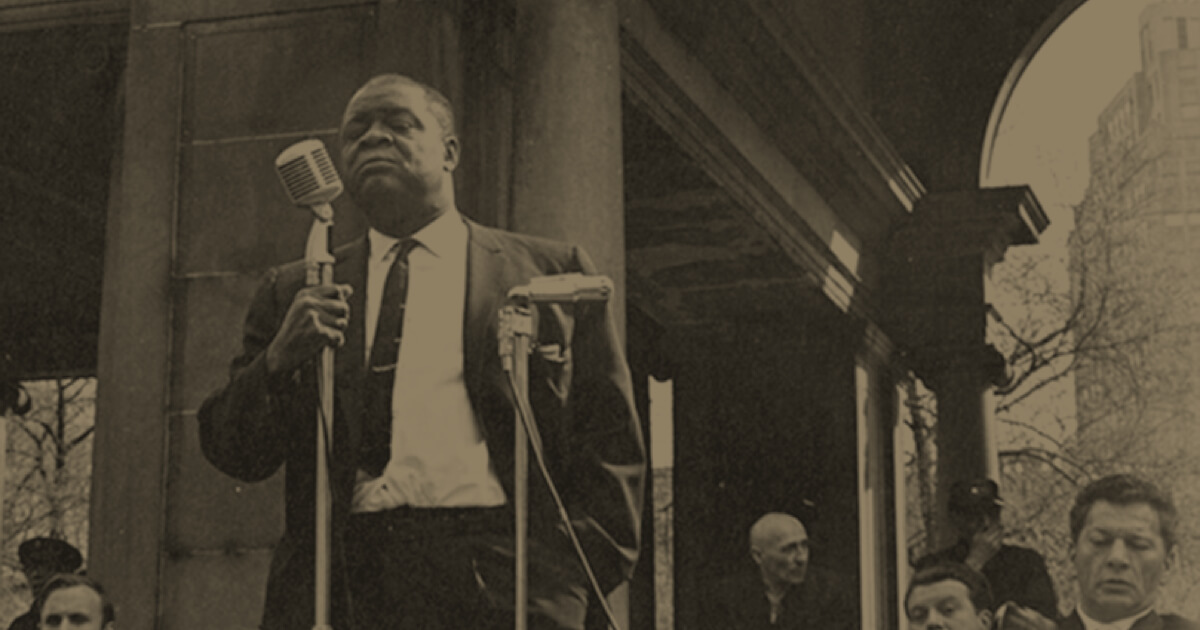From the 1920s to today, American tax policy has evolved to reflect one principle—the investor comes first — with disastrous implications for the rest of us.
Last Saturday, tens of thousands of protesters across the country joined the Tax March, although most realized Trump won’t divulge anything about his taxes unless Congress or the courts take action. So we may never know the truth about Trump’s income and charitable contributions, about the conflicts of interest and the “emoluments” from foreign powers.
Trump’s already said a lot about his taxes. In the first presidential debate, he famously boasted that his ostensibly legal tax avoidance strategies prove he’s “smart“—and by extension, so are the rest of the rich who do likewise. With Republicans controlling both the White House and Congress, the stage is set for massive tax cuts to reward those brilliant members of the 1 percent—unless popular ire over Trump’s tax filings can be translated into demands for tax justice.
Polls suggest that Americans won’t stomach a tax plan that will enrich the rich at the expense of the rest. In 2016 Gallup found that 61 percent of Americans agreed that “upper income people” paid “too little” in taxes. And a majority (52 percent) concurred that “our government should redistribute wealth by heavy taxes on the rich.”
Debates about federal taxes tend to focus on the tax rates levied on ordinary earned income and on tax deductions taken mostly by wealthy households. But there’s another front in the battle for tax justice: the tax code’s preferential treatment of income from capital gains (that is, from profits on investments). 1 This preference fuels inequality and financialization alike.
Thanks to this tax break for capital gains, households keep more of their income from investment after taxes than they keep from their wages and salaries. This is because income received from profits on the sale of investments is taxed at a lower rate than the same amount of income from salaries and wages. Because the wealthiest households earn the bulk of capital gains every year, the tax code’s preference for this form of income overwhelmingly benefits the rich.
In 2016, for example, nearly 76 percent of all capital gains went to households earning more than $1,000,000, according to estimates by the Tax Policy Center. And 96.2 percent of the households in the top 1 percent of the income distribution are white. Preferential treatment for capital gains meant that the federal government forewent $109.5 billion in taxes in 2016, a giveaway second only to the tax exclusion for employers’ contributions to employees’ health plans.

Illustration by Isableh
The tax break for capital gains also enables the oversized financial sector to wield enormous influence on the U.S. economy. It encourages corporate executives to take stock-based compensation, because it’s taxed more lightly than the same amount of salary income would be. This practice encourages executives to obsess over short-term stock-market performance at the expense of the long-term success of the corporation.
The capital gains tax preference might seem wonkish, but it cuts straight to the heart of neoliberalism because fundamentally, it rests on the assumption that investors and investment matter most in our economy and in our society—and therefore, tax policy should privilege these actors and these practices. It presupposes that financial markets guarantee the economic self-determination of all those who strive to invest. And it assumes that those markets recycle capital gains back into the economy to fund entrepreneurs, business expansion, and employment—despite all evidence to the contrary.
Abolishing the tax break for capital gains would destroy a key mechanism of inequality and financialization. And a strike against this preference would force a reconsideration of the ideological predilections deeply embedded in our economic policies—such as the tax code—that continue to sustain neoliberalism in a post-Brexit, Trumpian world.
The equalization of tax rates on different forms of income might seem like a top-down, technocratic liberal fix. But in fact, it would radically reorient the U.S. tax code according to a simple democratic principle: everyone’s income counts the same.
It’s true that the tax code’s preferential treatment of capital gains reflects the fact that both Democrat and Republican policymakers have prioritized the interests of the wealthiest in recent decades. But that’s not why the capital gains preference exists in the first place. Nor does it explain its remarkable endurance. For nearly a century, the tax code’s preference for investment gains has enjoyed the support of shifting and often surprising coalitions. And for nearly a century, the tax break for capital gains has persisted because it advanced the accumulation of white wealth.
The Interwar Period: “Restore Confidence to Capital!”
The Revenue Act of 1921 introduced a preferential or reduced tax rate on income from capital gains into the U.S. tax code, in a reversal of how policymakers had thought about different forms of income for several decades. When Congress deliberated over adjusting the tax code to peacetime conditions after the First World War, even Treasury Secretary Andrew Mellon, a champion of austerity, argued that reducing the tax rate on earned (wage) income relative to unearned (capital gains) income would spur industry and thrift amongst the working classes.
But Mellon’s remedy for postwar depression, inflation, unemployment, and radicalism was out of step with new ways of thinking about the relationship between citizenship and investment. Millions of Americans had purchased some form of federal bond during the First World War. The Liberty bond and War Savings sales campaigns broadcast a new model of the economy that put investors in the drivers’ seat. Building upon longstanding and widely-held beliefs that broad-based property ownership secured the independence and virtue of citizens, the Liberty bond and War Savings drives stretched the meaning of property to encompass financial investments and championed the ideal of a mass-investment society.
So when Congress deliberated over the Revenue Act of 1921, investment income no longer seemed as plutocratic as it once had. In Congressional hearings, a consensus that the income tax code should “be trying to protect . . . the investor” emerged. Based upon this consensus, the Revenue Act of 1921 separated different forms of income and honored investors with a 12.5 percent rate on capital gains income, well below the top rate of 50 percent for ordinary income from wages and salaries.
This tax break survived the Great Depression and the Second World War, thanks largely to the efforts of the nation’s foremost stock exchange and conservative southern Democrats. These critics of the New Deal came to view investors as a constituency that might be mobilized across the Mason-Dixon line.
In 1934, plummeting tax receipts and revelations that some of the wealthiest Americans avoided paying any income tax pushed Congress to hike tax rates on capital gains (still, they remained well below the rates levied on earned income). In response, the New York Stock Exchange (NYSE)—the self-proclaimed “Citadel of Conservatism”—rallied to demand the elimination of capital gains taxes. “Restore confidence to capital!” NYSE president Richard Whitney roared. Economic recovery “must come in the future as in the past, through the initiative of private enterprise, the intelligence of private management and the courage of private capital.”
The call to abolish taxes on capital gains was part of a broader rejection of the still-evolving New Deal, particularly the National Industrial Recovery Act (1933), the National Labor Relations Act (1935), and deficit spending on the part of the federal government. Refusing all these as dangerous incursions against private enterprise, NYSE leaders and spokesmen demanded a different approach. The elimination of capital gains taxation would provide investors with the “incentive” to start buying and selling assets again. When trading in bonds and stocks picked up, it would set in motion the capital now “frozen” in existing investments. In other words, more trading would release funds for reinvestment in new, innovative businesses, leading to more, better, and cheaper goods and services; more jobs; more productivity; less inflation; faster economic growth; and ultimately, more tax revenue for the Treasury.
This model anticipated the supply-side economists of the 1970s and 1980s who came to power as economic advisors in the Reagan administration, but it could boast of little (if any) empirical support when first developed by the NYSE in the 1910s, when deployed against the New Deal in the 1930s, or at any time since.
Then as now, when investors trade stocks and bonds, money passes from those who wish to buy to those who wish to sell. Corporations and others who issue securities receive nothing from these trades (except during an initial public offering). Those who earn capital gains by profitably trading stocks or bonds (or selling a home, a business, a barrel of oil, or a derivative contract) might reinvest in new and promising ventures that create jobs and grow the economy. But history suggests they are more likely to spend those gains, or to reinvest them in an asset bubble.
In the battle against capital gains taxes, the NYSE forged a new meaning for the term “incentive.” According to this model, incentives are used to encourage individuals to enter markets, where they can achieve optimal outcomes for themselves and for society. Over time, incentives spread beyond tax policy into social policy, environmental policy, educational policy, and more. Eventually, this meaning of “incentive” would inform supply-side economics’ demands for marginal tax cuts on the highest earned incomes. Today, “incentives” are used everywhere to elicit desired behavior without outright coercion: for example, the 401(k) match, stock-based compensation (or “incentive pay”), and incentive-based management. The concept of incentives has even crept into parenting advice—the Kazdin Method argues that such rewards work better than punishment as a form of discipline.
In 1937, the double-dip “Roosevelt Recession” and a wave of labor strikes hit the U.S. economy. Conservative lawmakers in both parties, business groups, and economists hostile to any economic stimulus all shared concerns about the centralization of federal and presidential power, the potency of labor, and budget deficits. They embraced NYSE tax policy recommendations, its model of the financial securities markets, and its language of incentives.
In Congress, a new cluster of conservatives from both parties hurled a salvo against the New Deal by demanding the elimination of capital gains taxes. When Roosevelt threatened a veto, Senators Josiah W. Bailey (D-NC) and Arthur Vanderburg (R-MI) consulted with leaders of finance and industry in New York City. The result was a “declaration of principles” authored primarily by Bailey. The press dubbed it the “Conservative Manifesto.”
The reduction of capital gains taxes stood at the top of the list of demands, which included states’ rights, a balanced budget, “the maintenance of law and order” in labor relations, “local responsibility” for the “deserving” poor and unemployed, and removing government interference from the economy. NYSE brokerages, chambers of commerce, and dozens of other business associations circulated an estimated 2 million copies of this early and influential anti–New Deal playbook.
Requests for NYSE speakers and literature poured in from business associations, particularly ones located in the south and west. These audiences listened eagerly to claims that incentives for private investment—in the form of tax reductions to encourage trading in stocks and bonds—would kickstart the economy and preserve political freedom.
Under the Revenue Act of 1938, tax rates on capital gains actually fell in the midst of the Great Depression. And they fell once again, during the Second World War, even as the Revenue Act of 1942 raised tax rates on ordinary income from wages and salaries and required that most American households file a tax return for the first time. The capital gains preference didn’t merely survive modern liberalism; it became one of its most entrenched and enduring features.
It might seem odd that the government eased off a source of revenue even as the federal debt ballooned to pay for the Second World War. And perhaps only Emil Schram could make the case. In 1941, Schram became one of the most highly paid executives in the country when he joined the NYSE as its president, stepping down as chairman of the Reconstruction Finance Corporation (RFC)—a federal agency that had helped to keep the U.S. economy afloat for more than two decades by extending loans to banks, railroads, businesses, sub-national governments, agriculture, and more. Even before the U.S. entered the war, the RFC expanded to support a military build-up, launching new experiments in the financing and ownership of plants and infrastructure.
At a time when business leaders packed up for Washington, D.C. to serve the government as “dollar-a-year” men, NYSE president Emil Schram headed in the other direction. After the Great Depression, and in the midst of massive government-led economic mobilization, claims about the behavior of investors and the requirements of capital were more convincing when voiced by a New Dealer. While the number of households paying the capital gains tax—and the significance of the stock market—remained quite limited, the question of whether or not American capitalism ever would or even could wean itself off government financing had become a matter of public concern.
Emil Schram earned his outsized salary. Lobbying hard and traveling widely, he explained to politicians, associations of corporate managers, financial executives, and businessmen, and at campaign rallies that further tax breaks for capital gains would “free equity capital.” This would help to finance “the defense effort” while at the same time it would “increase the revenue derived from the capital gains tax itself” because “the amount of tax revenue is in inverse proportion to the tax rate.” (Here, Schram long predated Arthur Laffer’s infamous curve.) Taxing gains from investments “destroyed incentive,” Schram contended. It rendered venture capital “impotent.”
In truth, the venture capital industry did not yet exist, and U.S. businesses looked to their own earnings, to bank loans, or to the RFC for financing. This last—especially the RFC’s Defense Plant Corporation—augured a “socialistic trend of dangerous significance” to its own former chairman, to his new friends in the brokerage and banking communities, and to many in his audiences.
Not content with the wartime reduction on capital gains tax rates, Emil Schram and his colleagues articulated an agenda for postwar economic reconversion. It coupled further cuts to tax rates on investment gains with the privatization of all RFC programs in order to “facilitate free flow of venture capital” and to “provide the necessary incentives to the stimulation of private enterprise.” Together, these would “achieve maximum production and maximum employment” after the war. NYSE leaders also warned against any “new taxes” with “social purposes rather than revenue as their main objective.”
The Postwar Boom: “Own Your Share”
In 1946, in the midst of a deep postwar recession and a historic surge in strike activity, and just as the CIO set in motion Operation Dixie to organize black and white workers in the South, the NYSE launched its own campaign to “educate” the public on postwar economic “requirements.” Its excoriations of the New Deal as a “regimented form of security” fit with the business community’s intensifying defense of “free enterprise.” Resurgent business conservatism—including a backlash against Operation Dixie—helped Republicans capture the Senate in 1946.
Even so, pro-business, anti-labor Republicans, business organizations, and the conservative press rarely defended or demanded tax breaks for capital gains—either during the war or in the decades after. Those groups spied far greater threats to recovery, to growth, and to liberty in corporate profit taxes, in high top marginal rates on earned income, and in sluggish depreciation schedules for corporate assets. 2 Indeed, most postwar free-enterprisers never acceded that capital gains taxes—paid by individuals on profits from investment—mattered very much.
Despite what the NYSE claimed, corporate reinvestment of retained earnings continued to fund the bulk of economic expansion in the decades after the Second World War. And although the percentage of American households owning stocks rose from 11 percent in 1952 to 24 percent in 1964—thanks to the NYSE’s “Own Your Share” campaign—the proportion of yearly income that the average investor earned from profits on investments remained tiny.
If the capital that is required for industrial expansion and for maintaining full employment . . . is not provided by private investors then the alternative is Government financing…
And despite the NYSE’s demands, the federal government stuck around in the financial markets. In 1958, the Small Business Administration (SBA) established the Small Business Investment Company program (SBIC). The SBIC spurred the venture-capital industry by licensing and financing privately owned and operated investment firms which, in turn, invested in high-risk small businesses.
Did the low incidence of stock ownership and the centrality of the state and of corporate earnings in the financial system signal the demise of individualism in the national economy? This question troubled the NYSE and its allies. “If the capital that is required for industrial expansion and for maintaining full employment . . . is not provided by private investors,” NYSE Chairman Robert P. Boylan warned, “then the alternative is Government financing”—socialism.
Conservative southern Democrats sympathized. They took up the NYSE’s vision of a mass-investment society. They envisioned a new political alignment that might preserve private property and white supremacy. They turned their critique of finance on its head in the service of a tax policy that quickened the accumulation of wealth by white households.
In Whither Solid South? A Study in Politics and Race Relations (1947), Charles Wallace Collins—theorist of the Dixiecrat movement—proposed the core beliefs upon which a new “Conservative Party” might be established. These included the freedom of “private capital in the hands of free individuals,” the “freedom to risk venture capital . . . unhampered by the controls of national planners,” the “wide dissemination of private ownership of property” in the form of corporate stock ownership, the “preservation of local self-government in the States, counties, and municipalities,” and the rejection of “Negro equality.” Only a “North-South coalition” of propertied whites could save the United States from “two virulent issues—Negro equality and State capitalism.”Already, the national Democratic Party had capitulated, in Collins’ estimation.
Conservative southern Democrats like Senator Harry F. Byrd, Sr.—champion of “massive resistance” against desegregation of schools, ardent anti-monopolist, filibusterer of the Civil Rights Act, chairman of the Senate Finance Committee (1955–1965), and all-around heavyweight against the agenda of equality—viewed the preferential treatment of capital gains as a push against the economic and political power of Big Labor, Big Business, and Big Government. Byrd agreed that independent businessmen, farmers, and investors deserved this “incentive” of knowing that when they sold their assets, those gains would be taxed more lightly than were the profits of big corporations, or the salaries and wages of toiling citizens. And because tax breaks do not require the federal government to spend tax revenues—rather, it simply doesn’t collect them—lawmakers like Byrd could allow themselves to believe the preferential treatment of capital gains was budget-neutral.
They could pretend the capital gains preference was race-neutral, too. Indeed, it was just the kind of disguised social policy that an intransigent advocate of both balanced budgets and racial segregation could love. Because so few African Americans held investments, the capital gains preference gave advantage to propertied whites, multiplying their wealth over time and across generations.
Liberal southern Democrats were equally important for holding down the capital gains tax rate at 25 percent until 1967. This feature of the tax code fit with their inclination to hide the ways in which the modern welfare state advanced the interests of white Americans. After all, white professionals and managers, newly capable of financial investment, actually received income from capital gains. It also fit with the Democratic Party’s shift in the 1960s towards thinking about tax policy more in terms of growth than in terms of fairness.
None proved so stalwart a defender of this preference as Senator Russell Long (D-LA, 1948–1988), son of Huey Long, the populist governor of Louisiana assassinated in 1935. Russell Long replaced Harry Byrd, Sr., as chairman of the Senate Finance Committee (1965–1981) and he chaired other important joint committees on taxation (1967–1977). A champion of the Great Society, Long whipped his Democrat colleagues in Congress during the Johnson administration (1965–1969). He could claim credit for the passage of Medicare and the earned income tax credit.
Where Governor Long once demanded that Americans “Share our Wealth,” Senator Long encouraged them to “Own Your Share.” The father’s concern for the “little man” morphed into his son’s conviction that the tax code should encourage the small investor. He protected preferential rates for capital gains income and he secured tax breaks to encourage corporations to develop employee stock-ownership plans. “You’re going to have to have capital to have capitalism,” Long quipped. So faithful was Long that the NYSE appointed him to its board of governors when he retired from Congress in 1987.
The NYSE’s mid-century “Own Your Share” and “People’s Capitalism” campaigns defended the capital gains tax break while promoting mass stock ownership—in contrast to the welfare state or benefits tied to jobs—as the guarantor of genuine opportunity and security for responsible individuals. “Let’s not allow our search [for security] to carry us into a bed of feathers which will stifle initiative and smother progress,” NYSE president G. Keith Funston warned. “I believe my best chances for security lie not in the prospect of my social security check at age 65, but rather in my opportunity to compete in a free society and to participate in the new developments created by men of vision who have the incentive to venture and to take a risk.” In this view, it was not the distribution of wealth or income, but the extent of asset-ownership—particularly stock-ownership—that mattered most.
In the late 1960s, inflation rose, economic growth slowed, and federal deficits returned. All across the political spectrum, Americans loudly voiced dissatisfaction with the tax code. Many targeted the preferential treatment of capital gains for reform. Keynesians sought to reduce rates on earned income to kick-start growth. Fiscal conservatives were determined to bust deficits by raising more revenue, however possible. Tax revolts of all sorts broke out across the country. Those on the left clamored for a more progressive redistribution of the nation’s tax burden.
The tax rate on capital gains income rose after 1967, hitting its highest point since the First World War (39.9 percent) in 1976. That same year, candidate Jimmy Carter promised he would try to treat all income the same if elected president.
But a new generation in Congress quashed Carter’s proposal to raise tax rates on capital gains to match those levied on earned income. Democrats from the west and southwest—including Lloyd Bentsen (D-TX), James Jones (D-OK), and Al Ulmann (D-OR)—exceeded Russell Long in their enthusiasm for the capital gains preference. Thanks to loopholes added over the years, the profits from commodities produced or extracted in their districts were taxed at capital gains rates rather than at higher corporate profit or earned income rates. These Congressmen demanded reductions in capital gains tax rates, as did up-and-comers across the aisle. William Steiger (R-WI) and Jack Kemp (R-NY) insisted that reductions would release funds for investments that would counter deindustrialization in their districts, a notion fed to them by both NYSE leaders and a new breed of supply-side scholars, pundits, and journalists.
1970s On: The Price of Growth
Wall Street met Silicon Valley in the lobbies of Congress in the 1970s. Newly formed groups that claimed to represent the venture capital and high-tech industries arrived from California (American Council for Capital Formation, 1973; National Venture Capital Association, 1973; and the American Electronics Association, 1977). Much like the NYSE had done for years, they counseled Congressmen that cutting tax rates on capital gains would improve “capital formation.” Representative Steiger reported that high-tech industries and venture investors regarded the Tax Reform Act of 1969 which increased the tax on capital gains as “the root cause” of inadequate capital formation in the 1970s. By narrowing the “gap between ordinary income and capital gains,” that act had “weakened the financial incentive to invest,” Steiger charged.
The changing of the guard that stood behind the preferential treatment of capital gains whitewashed the racially biased origins of that policy. Arguments about the importance of entrepreneurial investment by individuals for revitalizing and modernizing the economy obscured how the preference always had—and always would—benefit whites, almost exclusively. These arguments also buried the historic connections between high tech, venture capital, and federal support through military contracts and the SBIC program.
With the Revenue Act of 1978, policymakers from both parties rallied behind Steiger’s call to slash tax rates on capital gains. “This country has prospered because we have had a free enterprise system that has encouraged the entrepreneur, the small businessman, to take a risk with the understanding that he was going to be able to keep some of it, if he won,” related Senator Lloyd Bentsen (D-TX). Current rates on capital gains offered no such incentive, Bentsen warned. “[R]isk-takers are overtaken by caretakers. If you do not leave something for the risk-takers, there is not going to be anything for the caretakers to care for.” Senator William Roth (R-DE) agreed. Urging his colleagues to consider “the long-range consequences of our tax policies” on “our free society,” Roth concluded, “I feel strongly that the locus of investment decisions should be with the private individuals” who required the incentive of tax cuts on capital gains.
“Republicans can take heart for the first time since the ‘New Deal.’ Economic common sense and individual rights are indivisible—at long last,” NYSE leader Fred Alger congratulated William Steiger when Carter signed the Revenue Act of 1978. The brokerage industry geared up to fund a presidential bid for Steiger, but he died of a heart attack that same year (NYSE members would back Ronald Reagan in 1980 instead).
The candidate was less important than the concession. When law-makers in both parties passed the Revenue Act of 1978, they came to an agreement that “any capital formation technique” would necessarily benefit “high-bracket taxpayers” more, in the words of Al Ullmann (D-OR).
In other words, they accepted inequality as a fair price to pay for growth.
Tax Preference as White Privilege
Little evidence indicates that the tax break for capital gains benefits the economy overall, although its relationship to inequality is quite clear. It’s true that a majority of American households own stocks. But still, the tax break for capital gains benefits these households very little because they mostly hold stocks in tax-free accounts. The tax-exempt institutional investors that account for most venture capital investment—pension funds, college endowments, foundations, and insurance companies—don’t pay capital gains taxes, either. (The National Venture Capital Association estimates that only 10 percent of investors in venture capital funds were individuals and families subject to capital gains taxes.)
The net worth of the median white household was thirteen times greater than the net worth of the median African-American household in 2013.
For nearly a century, critics have pointed out that tax breaks for capital gains are a form of class privilege. What’s less often recognized is how the preference contributes to white privilege, too.
The net worth of the median white household was thirteen times greater than the net worth of the median African-American household in 2013. Forty percent of all African-American households were reported to have zero or negative net worth. And for black households that own assets, only 3.4 percent are the kind of financial assets that might receive a capital gains tax break (as opposed to 17.1 percent for white households), according to Edward N. Wolff. 3
The tax code’s preferential treatment of income from capital gains may appear color-blind, but it’s not—not in its consequences and not in its historical origins. Historians have long recognized that racially biased policies to promote homeownership built the white middle class. The preferential treatment for capital gains gave rise to the white 1 percent.
Eliminating tax breaks for income from investment won’t increase the wealth of black households or the wealth of households located below the 1 percent. But it could generate tax revenues for the kinds of public programs and investments that might. It could put a drag on the inexorable rise of the 1 percent and the persistent trend of financialization.
And it would deliver tax justice.
Julia Ott is Associate Professor in the History of Capitalism and the co-director of the Robert L. Heilbroner Center for Capitalism Studies at the New School. She is the author of When Wall Street Met Main Street: The Quest for an Investors’ Democracy (Harvard University Press, 2011). Ott co-edits Columbia Studies in the History of U.S. Capitalism for Columbia University Press and serves as Senior Editor for Public Seminar.
This article was originally published in Dissent magazine.













